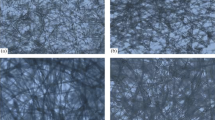Abstract
This second part of a systematic study of the properties of crosslinked-oriented gelatin involves the effects of orientation and water content on the glass transition temperature Tgand on the melting behavior. The samples were the same as those in the preceding study, and their transition temperatures were determined by both differential scanning calorimetry and dynamic mechanical thermal analysis. The crosslinked gelatin which had been room-conditioned showed two transition temperatures: the lower one was attributed to Tg of the water-plasticized gelatin, and the higher one was interpreted as Tg of dried gelatin superimposed by melting. A rather unusual situation arose because of the fact that the Tg and melting temperatures Tm (217 and 230°C, respectively) are so similar. Using water as plasticizer not only decreases Tg but produces imperfect crystallites which melt below the Tg of the system. The presence of the amorphous phase in the glassy state would presumably make it essentially impossible to define a melting point or crystallization temperature in the normal manner, as an equilibrium between crystalline and amorphous phases.
Similar content being viewed by others
References
Fakirov S, Sarac Z, Anbar T, Boz B, Bahar I, Evstatiev M, Apostolov AA, Mark JE, Kloczkowski A (1996, Part I) Colloid Polym Sci 274:334
Yang Y, Mark JE, Kloczkowski A, Er-man B, Bahar I (1994) Colloid Polym Sci 272:284
Erman B, Bahar I, Kloczkowski A, Mark JE (1991) Macromolecules 23:5335
Bahar I, Erman B, Kloczkowski A, Mark JE (1991) Macromolecules 23:5341
Erman B, Bahar I, Kloczkowski A, Mark JE (1992) In: Mark JE, Erman B (eds) Elastomeric Polymer Networks. Prentice Hall, Englewood Clifs, NJ
Erman B, Haliloglu T, Bahar I, Mark JE (1991) Macromolecules 24:901
Erman B, Bahar I, Kloczkowski A, Mark JE (1992) In: Noda I, Rubingh DN (eds) Polymer Solutions, Blends, and Interfaces. Elsevier, Amsterdam
Kloczkowski A, Mark JE, Erman B, Bahar I (1992) In: Noda I, Rubingh DN (eds) Polymer Solutions, Blends, and Interfaces. Elsevier, Amsterdam
Erman B, Bahar I, Kloczkowski A, Mark JE (1992) In: Aharoni SM (ed) Synthesis, Characterization, and Theory of Polymeric Networks and Gels. Plenum, New York
Ross PI (1987) In: Mark HF, Bikales NM, Overberger CG, Enges GM (eds) Encyclopedia of Polymer Science and Engineering, Vol 7, Wiley, New York, p 488
Sarac Z, Fakirov S, Anbar T (1994) Polymer networks ’94, Prague, July 25–29
Davis P, Tabor BE (1963) J Polym Sci Part A 1:799
Fakirov S (1990) Visokomol Soedin 32:878 (in Russian)
Fakirov S, Gogeva T (1990) Makromol Chem 191:615
Mandelkern L (1964) Crystallization of polymers. McGraw-Hill, New York
Author information
Authors and Affiliations
Rights and permissions
About this article
Cite this article
Fakirov, S., Sarac, Z., Anbar, T. et al. Mechanical properties and transition temperatures of crosslinked-oriented gelatin. Colloid Polym Sci 275, 307–314 (1997). https://doi.org/10.1007/s003960050087
Received:
Issue Date:
DOI: https://doi.org/10.1007/s003960050087




